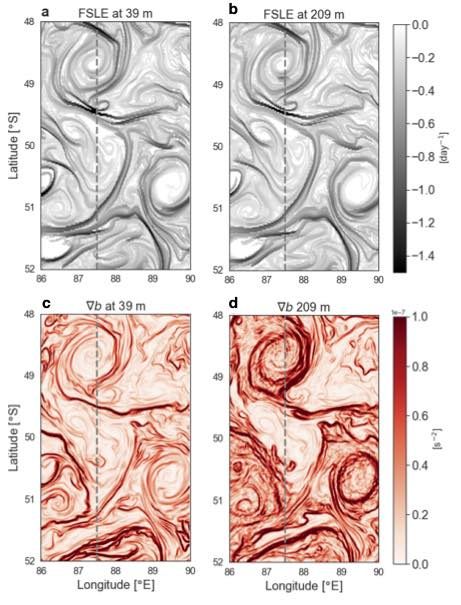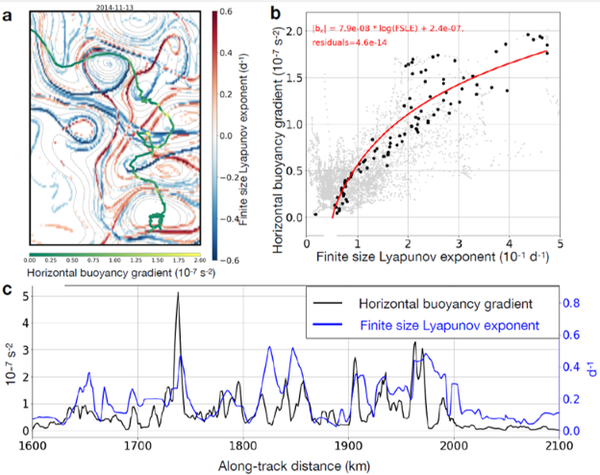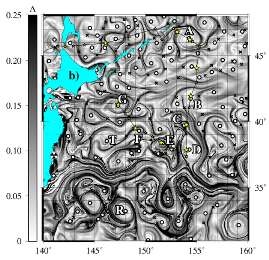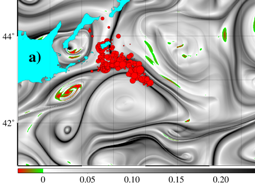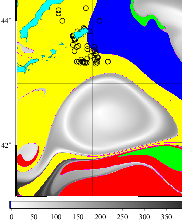FSLE: Examples of applications with Lyapunov exponents in general
The Lyapunov Exponents can be widely used in very different topics. Many authors calculated their own products to perform their studies. This page is dedicated to an overview of existing studies showing the use of Lyapunov Exponents. This page will evolve based on your studies on that subject. If you are interested in showing your results via this page, feel free to contact us: aviso(at)altimetry.fr
PHYSICS AND CLIMATE
Altimetry-Based Diagnosis of Deep-Reaching Sub-Mesoscale Ocean Fronts
In this study, Siegelman et al., demonstrate that the FSLEs distributed by AVISO+ allow the reconstruction of sub-mesoscale dynamics down to 500 m in the ocean interior. More precisely, they highlight a relation between FSLE at the surface and lateral buoyancy gradients at depth. This work proposes an innovative methodology to recover the correct orientation and strength of sub-mesocale fonts that should be useful to the physical oceanographic community to analyze their sub-mesoscale-resolving datasets and plan future oceanographic field campaigns.
FSLE at (a) 39 m, (b) 209 m and |∇ b| at (c) 39 m, (d) 209 m. Randomly selected snapshot taken on 27 October 2011 from a numerical simulation. See Siegelman et al. Fluids (2020)
Reference:
Siegelman, L.; Klein, P.; Thompson, A.F.; Torres, H.S.; Menemenlis, D. Altimetry-Based Diagnosis of Deep-Reaching Sub-Mesoscale Ocean Fronts. Fluids 2020, 5, 145. https://doi.org/10.3390/fluids5030145
Heat is going up in the Kerguelen fronts, following elephant seals
In their Antarctic Circumpolar Current vertical heat transport study, Siegelman et al demonstrated that submesoscale fronts are shown to drive vertical upward heat transport from the ocean interior back to the surface that is larger than other contributions to vertical heat transport. They showed that the FSLE estimations and buoyancy gradients at 300m estimated from data collected by a female elephant seal are in good agreement as well as the relationship linking the two (see figures).
This study suggests that the submesoscale ocean dynamics play a crucial role in the earth heat budget of the climate system.
Also in the image of the month, January 2020.
FSLE and horizontal buoyancy gradients (|bx|). a, A snapshot of FSLE and SSH contours (dashed grey) for 13 November 2014 in the strongly turbulent region, with surface |bx| from 2 November to 24 November 2014. b, A scatter plot of along-seal-track stretching FSLE and |bx| at 300 m, over the entire trajectory, after a 30 km moving average and averaging the y axis over 100 bins (black dots), with unaveraged data in grey. The relationship obtained between FSLE and |bx| is given in red. c, Along-seal-track time series of stretching FSLE (blue) and |bx| at 30 m (black) after a 5 km moving average.
Reference:
- Lia Siegelman, Patrice Klein, Pascal Rivière, Andrew F. Thompson, Hector S. Torres, Mar Flexas, Dimitris Menemenlis, 2019: Enhanced upward heat transport at deep submesoscale ocean fronts, Nature Geoscience, https://doi.org/10.1038/s41561-019-0489-1
Societal applications
Oil spills and red tides
Lagrangian Coherent Structures (LCSs) identified using techniques similar to the FSLE, the so-called geodesic theory of LCS by Haller and Beron-Vera (2012), have been also used to monitor dispersion patterns of red tides, and oil spills. In Olascoaga et al. (2006), LCSs extracted from simulated currents suggested the presence of a resilient barrier to transport across the West Florida Shelf which provides a large degree of isolation that favors red tide development. The dispersion of the nutrients released by rivers in the Gulf of Mexico that could trigger a red tide event was analyzed in Olascoaga et al., 2008 and Olascoaga, 2010.
Persistently attracting cores of simulated geodesic LCSs were found to predict with a few days of anticipation fingering instabilities in the oil slick produced by the Deepwater Horizon spill (Olascoaga and Haller, 2012). More recently, and relying on currents from the Aviso product, Olascoaga et al. (2013) predicted similar fingering patterns in drifting buoys from the Grand Lagrangian Deployment (GLAD) carried out in the northern Gulf of Mexico to gain insight into its circulation in connection to the transport of hydrocarbons.
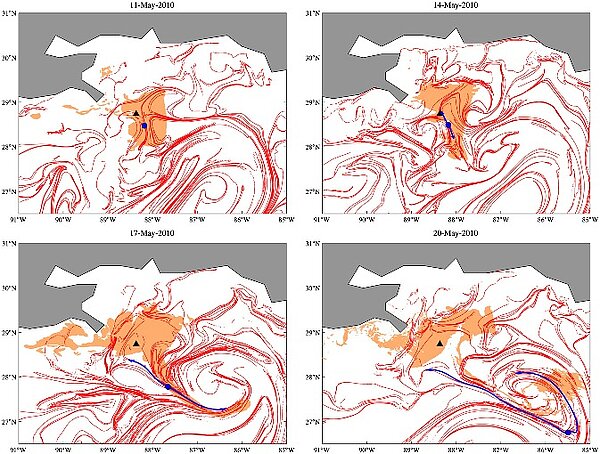
References:
- Olascoaga J.M. Rosentiel School site
- Haller, G., and F.J. Beron-Vera (2012). Geodesic theory of transport barriers in two-dimensional flows. Physica D, 241(20), 1680-1702.
- Olascoaga, M.J., and G. Haller (2012). Forecasting sudden changes in environmental pollution patterns. PNAS, 109(13), 4738-4743.
- Olascoaga, M. J., F. J. Beron-Vera, G. Haller, J. Trinanes, M. Iskandarani, E. F. Coelho, B. Haus, H. S. Huntley, G. Jacobs, A. D. Kirwan, Jr., B.L. Lipphardt, Jr., T. Özgökmen, A.J.H.M. Reniers, and A. Valle-Levinson (2013). Drifter motion in the Gulf of Mexico constrained by altimetric Lagrangian coherent structures. Geophys. Res. Letters., 40(23), 6171–6175.
- Olascoaga, M. J., F. J. Beron-Vera, L. E. Brand, and H. Kocak (2008), Tracing the early development of harmful algal blooms on the West Florida Shelf with the aid of Lagrangian coherent structures. J. Geophys. Res., 113, C12014, doi:10.1029/2007JC004533.
- Olascoaga, M. J. (2010). Isolation on the West Florida Shelf with implications for red tides and pollutant dispersal in the Gulf of Mexico. Nonlin. Proc. Geophys., 17, 685-696.
- Olascoaga, M. J., I. I. Rypina, M. G. Brown and F. J. Beron-Vera, H. Kocak, L. E. Brand, G. R. Halliwell, and L. K. Shay (2006). Persistent Transport Barrier on the West Florida Shelf. Geophys. Res. Lett., 33: L22603.
Oil spill
Oil spill in the China Sea resulting from the Sanchi tanker disaster (January 2018) superimposed with the FSLE products (unit days-1) for the same period.
Identifying eddies with the risk of contamination by Fukushima-derived radionuclides
The cruise of R/V “Professor Gagarinskiy” was conducted in the Northwest Pacific from 12 June to 10 July 2012 with the aim to measure artificial radionuclides after the accident at the Fukushima Nuclear Power Plant on 11 March 2011. FTLE and other Lagrangian maps computed on the velocity AVISO products and outputs of numerical models of circulation, are actively used in analyzing mixing and transport in the ocean ( Prants et al., 2011 DES, Prants et al., 2014 PNG, Prants 2013 PhScr, Prants, 2014 EPJST).
Those maps have been sent electronically each day to the board. They helped to correct the cruise track in order to cross prominent eddies in the area (Budyansky et al., 2015 DSR). Simulated distribution of radionuclides concentration to the end of June 2012 with measured concentrations of 134Cs and 137Cs are shown in figure below (left). The Lyapunov map in the right show anticyclonic eddies A, B, C, D, E, F and G which have been sampled at the surface and in depth. The results of observations are consistent with the simulated results. The highest concentrations of 134Cs and 137Cs have been found to exceed ten times the background levels before the accident. Maximal content of radiocesium was observed inside the mesoscale anticyclonic eddies. Among the sampled eddies, the eddy B and the Kuroshio warm-core ring G presented the highest concentration of cesium.
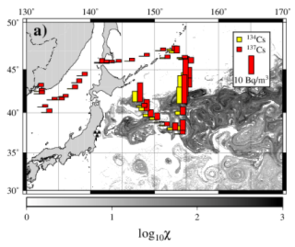
References:
- Prants S.V. Lab of Nonlinear Dynamical Systems
- S.V. Prants, M.Yu. Uleysky, M.V. Budyansky. Numerical simulation of propagation of radioactive pollution in the ocean from the Fukushima-Daiichi nuclear plant. Doklady Earth Sciences. V. 439 Part 2 (2011) 1179-1182
- S.V. Prants, M.V. Budyansky, M.Yu. Uleysky. Lagrangian study of surface transport in the Kuroshio Extension area based on simulation of propagation of Fukushima-derived radionuclides. Nonlinear Processes in Geophysics. V.21, 279-289, 2014. doi:10.5194/npg-21-279-2014
- S.V. Prants. Dynamical systems theory methods for styding mixing and transport in the ocean. Physica Scripta. V.87 (2013) art.no. 038115 10.1088/0031-8949/87/03/038115
- S.V. Prants. Chaotic Lagrangian transport and mixing in the ocean. The European Physical Journal Special Topics. V.223, Issue 13, pp 2723-2743 (2014) DOI: 10.1140/epjst/e2014-02288-5
- M.V. Budyansky, V.A. Goryachev, D.D. Kaplunenko, V.B. Lobanov, S.V. Prants, A.F. Sergeev, N.V. Shlyk, M.Yu. Uleysky. Role of mesoscale eddies in transport of Fukushima-derived cesium isotopes in the ocean. Deep Sea Research I. (2015), V.96, pp. 15-27 DOI information: 10.1016/j.dsr.2014.09.007
Biology
Identifying Lagrangian fronts with favorable fishery conditions
FSLE, FTLE and other Lagrangian diagnostics, based on the velocity AVISO products and outputs of numerical models of circulation, are actively used in analyzing mixing and transport in the ocean (see recent reviews by Prants, 2013 PhScr, Prants, 2014 EPJST).
Lagrangian fronts (LF) in the ocean are defined as boundaries between surface waters with strongly different Lagrangian properties (Prants et al., 2014 IAOP, Prants et al., 2014 DSR). To identify a LF it is necessary to evolve backward-in-time a large number of synthetic tracers in a velocity field, to compute their displacements D and code by color the tracers which entered the study area through its geographic borders. The border between different colors is a kind of the LF no matter how distinct are hydrological properties of the corresponding convergent waters. In practice any LF demarcates convergence of dissimilar waters. The water displacement map in figure opposite (bottom) of the LFs between waters of the Soya, Oyashio and Kuroshio currents in the Hokkaido – Kuril area. The colors show where the waters came from a month ago: yellow – from the west, green – the east, blue – the north, red – the south, grey – the waters that have been in the area during that month in the past. This map and the FTLE field in top clearly demonstrate a warm-core anticyclonic Kuroshio ring. The main locations of saury catches (circles) are accumulated around that eddy near the LFs which “attract“ passive marine organisms, a food for saury.
References:
- Prants S.V. Lab of Nonlinear Dynamical Systems
- S.V. Prants, M.V. Budyansky, M.Yu. Uleysky. Lagrangian fronts in the ocean. Izvestiya, Atmospheric and Oceanic Physics. 2014, V. 50, N3 , p.284-291.
- S.V. Prants, M.V. Budyansky, M.Yu. Uleysky. Identifying Lagrangian fronts with favourable fishery conditions. Deep Sea Research I. V. 90, p.27-35 (2014) doi 10.1016/j.dsr.2014.04.012
- S.V. Prants. Dynamical systems theory methods for styding mixing and transport in the ocean. Physica Scripta. V.87 (2013) art.no. 03811510.1088/0031-8949/87/03/038115
- S.V. Prants. Chaotic Lagrangian transport and mixing in the ocean. The European Physical Journal Special Topics. V.223, Issue 13, pp 2723-2743 (2014) DOI: 10.1140/epjst/e2014-02288-5
